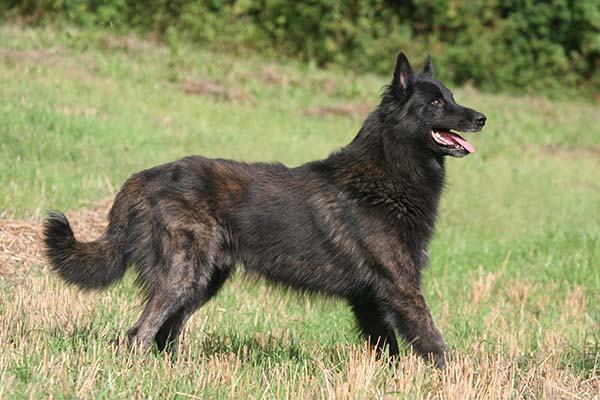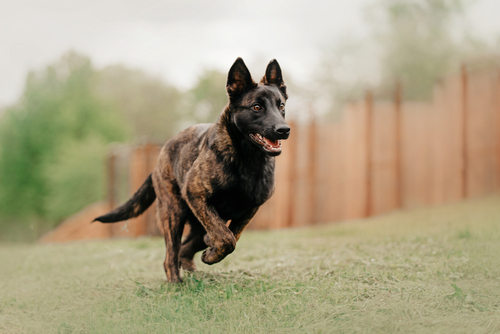Many people choose to have a Dutch Shepherd Protection Dog because they are fiercely devoted and cautious of strangers. They have strong working impulses, but because of their affectionate and amiable nature, especially when they’re around kids and other pets, they’re becoming increasingly popular pets. The Dutch Shepherd responds so well to protection and service training because they are dependable, vigilant, and highly intuitive.
The Dutch Shepherd is a very intelligent breed that welcomes a challenge and is willing to obey. This breed is highly intelligent, thus shorter training sessions with less repetitions work best for them. They also get more motivated when the activity gets more mentally challenging. It is strongly advised to provide obedience training to this breed as it will become quite autonomous and begin to make its own judgments without it. This breed, which has the temperament of a true shepherd, is gifted in a variety of areas, such as herding, scent tracking, IPO, obedience, and agility.
Our guide on how to train a Dutch Shepherd will teach you to be a confident and firm handler to avoid the stubborn streak common in this breed. We’ll begin with basic obedience training to ensure that your dog can respond to “sit”, “stay, “down”, recall and food refusal and fully socialise your canine in busy public spaces.
How to Train a Dutch Shepherd
Exercise is quite much required for the Dutch shepherd dog, at least twice a week. Because aggressive treatment of your dog will not yield satisfying results, mild Dutch shepherd dog training is advised. Making the decision to enroll in a Dutch shepherd dog training program begins with reading up on how to train a Dutch shepherd dog. Everyone, we’re sure, wants to have a happier, healthier dog that can behave normally in society, especially when it goes for walks.
If you learn effective ways on how to train a Dutch Shepherd, you will notice that your dog will no longer be walked on a leash and will have greater freedom to explore new areas. It will also learn how to respond to various situations. During their walks, the owner of the Dutch Shepherd dog will be more confident in his pet and will let it run wild.

Guidance on How to Tailor your Approach to Dutch Shepherd Training
Observe and Understand Your Dog
Take the time to observe your Dutch Shepherd’s behavior in various situations.
Note their reactions to different stimuli, their energy levels, and how they respond to commands.
Consider Their Temperament
Consider their temperament when learning how to train a Dutch Shepherd, because they can have varying temperaments—some may be more outgoing and social, while others may be reserved or independent. Adapt your training approach to cater to their specific temperament. For example, a more outgoing dog may enjoy group training classes, while a more reserved dog might benefit from one-on-one sessions.
Identify Motivations
Determine what motivates your Dutch Shepherd when learning how to train a Dutch Shepherd. Some dogs are food-motivated, while others may respond better to praise or play. Use their preferred motivators during training to keep them engaged and focused.
Adjust Training Intensity
Consider your Dutch Shepherd’s energy levels when considering effective ways on how to Train a Dutch Shepherd. Some dogs have a high energy drive and may thrive on more active training sessions, such as agility or interactive games. Lower-energy dogs may benefit from shorter, focused sessions with more mental stimulation.
Basic Dutch Shepherd Dog Training Commands
- Sit: After you put the dog collar and leash around your Dutch shepherd’s neck, you can train it to sit. The next step is to push down the dog’s back and pull up the leash till the dog sits. When your dog obeys your commands, give it praise.
- Stay: First ask your Dutch shepherd dog to sit. After that, ask it to stay while keeping the dog leash over the dog’s head and you are standing in front of your dog. If the dog wants to get up then pull the leash upwards until the dog is constrained to sit. Keep repeating the stay command until the dog will execute it without anyone’s help.
- Lie Down: In order to teach your Dutch shepherd dog the lie-down command, you must assist it while it is being used for the first time. When it comes to teaching your dog this command, you have two choices. To get the dog to lie down, first place your hand above its shoulder blades and softly press down. The second method involves forcing the dog to lie down by using the leash. To achieve it, drag the leash diagonally in the direction of the dog’s back until it falls to the ground. Until the dog can lie down on its own volition, you can keep trying these two methods.
- Stand: Every dog, especially puppies who are simpler to train, should be taught the fundamental Dutch shepherd dog training instructions. The final command on how to train a Dutch Shepherd will assist you in getting your dog to stand by using the collar as an adjutant object. Your dog will be forced to stand if you hold the collar and pull it forward. Remember to give the command aloud each time the dog assumes the necessary position.

How to Mentally Stimulate a Dutch Shepherd
Mentally stimulating a Dutch Shepherd is crucial to keeping them engaged, preventing boredom, and channeling their intelligence in positive ways. The following are various activities and techniques to provide mental stimulation for your Dutch Shepherd:
- Interactive Toys: Invest in puzzle toys that dispense treats when manipulated. This engages their problem-solving skills and keeps them mentally active.
- Hide and Seek: Hide treats or toys around the house or yard and encourage your Dutch Shepherd to find them. This taps into their natural hunting instincts and provides mental exercise.
- Training Sessions:Engage in short and frequent training sessions. Teach them new tricks, commands, or even agility exercises to keep their mind active and focused.
- Obedience Training Variations: Introduce variations to basic obedience commands. For example, practice commands in different rooms or environments to keep your Dutch Shepherd mentally engaged.
How to Train a Dutch Shepherd: Activities for Dutch Shepherd
Frisbee Racing
Frisbee and dog activities go hand in hand; Frisbee is probably the first thing that dog owners think of when they are brainstorming on how to Train a Dutch Shepherd and things to try out with their dogs. So that you could think about giving this contemporary Frisbee variation a try with your Dutch Shepherd, we thought we’d tell you about it. Throwing a Frisbee and then racing your dog to catch it is the basic concept behind Frisbee racing. Who gets to the Frisbee first doesn’t really important as long as you two are enjoying yourselves and connecting.
Agility Training
Dutch Shepherds may learn to move as elegantly as a dancer and as quickly as the wind, just like German Shepherds can. A tad excessive? Although this may sound a little dramatic, agility training may actually teach Dutch Shepherds how to move with grace, elegance, and poise. Given that Dutch Shepherds were bred and born to assist people in a variety of situations that call for them to be extremely dexterous, when learning how to train a Dutch Shepherd, agility training is really essential if you want your dog to work as a therapy animal or rescue.
Protection Sports
Since protection sports encompasses a wide range of activities on how to train a Dutch Shepherd, the final activity on our list may truly be viewed as an umbrella term. Any activity that meets the criteria for being classified as a protection sport would primarily focus on training your Dutch Shepherd how to keep people safe in specific situations and risks. You should look into introducing your Dutch Shepherd to protection sport activities as soon as possible if you intend to assist him become a guard hound. Protection sports are also an excellent way on how to train a Dutch Shepherd and to teach your dog restraint, even if you don’t want your dog to become a professional guardian.
Importance of Socialization in Dutch Shepherd Training

Exposing your Dutch Shepherd to various environments, people, and animals is a crucial aspect of their overall development and well-being. These are several reasons why this exposure is important:
- Early exposure helps develop proper socialization skills in Dutch Shepherds. It teaches them how to behave appropriately in different situations and around various individuals.
- When considering on how to train a Dutch Shepherd, familiarizing your Dutch Shepherd with different environments, people, and animals helps prevent fear and anxiety. Dogs that are well-socialized are generally more confident and less prone to fear-based aggression.
- Exposure to new experiences contributes to the development of confidence in Dutch Shepherds. Confidence is crucial for a well-adjusted and emotionally stable dog.
- Dogs that are not properly socialized may exhibit fear-based aggression. Exposure to different people and animals helps reduce the likelihood of aggressive behavior stemming from anxiety or insecurity when learning how to train a Dutch Shepherd.
READ ALSO
- How to Train a Belgian Malinois – A Comprehensive Guide and 3 Steps Approach to Train Belgian Malinois
- How to Train Anatolian Shepherd: 6 Exclusive Training Tips
- How to Train Cane Corso Complete Guide: 6 Training Techniques for a Happy and Obedient Dog
- A Comprehensive Guide on How to Train a Livestock Guardian Dog
- Nurturing Your Belgian Sheepdog Puppies: A Complete Guide to 5 Training Tips and Care
- Bullmastiff Dog – 6 Captivating Physical Appearance, Training And Health
FAQs
Are Dutch Shepherd easy to train?
Intelligent and Trainable: These dogs are highly intelligent and eager to learn, making them relatively easy to train. Their sharp minds and strong work ethic make them well-suited for obedience and agility training.
How do you mentally stimulate a Dutch Shepherd?
Using brain games is a fun and convenient way to get your Mali-Duchie thinking. There are plenty of games you can play with your pooch both indoors and out which require minimal materials. Treasure hunt and hide-and-seek are similar in nature because they both require your dog to do some detective work.
Are Dutch Shepherds stubborn?
The Dutch Shepherd might not be the most popular Shepherd out there, but that does not mean they are not up to the job. Because this breed is so smart, it is important to establish your role as the pack leader. With dogs that are this intelligent, a stubborn streak is a common occurrence.





